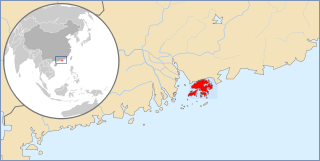Related Research Articles
ISO 3166-2:AU is the entry for Australia in ISO 3166-2, part of the ISO 3166 standard published by the International Organization for Standardization (ISO), which defines codes for the names of the principal subdivisions of all countries coded in ISO 3166-1.
A toll-free telephone number or freephone number is a telephone number that is billed for all arriving calls. For the calling party, a call to a toll-free number from a landline is free of charge. A toll-free number is identified by a dialing prefix similar to an area code. The specific service access varies by country.
A telephone numbering plan is a type of numbering scheme used in telecommunication to assign telephone numbers to subscriber telephones or other telephony endpoints. Telephone numbers are the addresses of participants in a telephone network, reachable by a system of destination code routing. Telephone numbering plans are defined in each of the administrative regions of the public switched telephone network (PSTN) and in private telephone networks.

In the United Kingdom, telephone numbers are administered by the Office of Communications (Ofcom). For this purpose, Ofcom established a telephone numbering plan, known as the National Telephone Numbering Plan, which is the system for assigning telephone numbers to subscriber stations.

The Australian telephone numbering plan governs the allocation of telephone numbers in Australia. It has changed many times, the most recent major reorganisation by the Australian Communications and Media Authority taking place between 1994 and 1998.

The French telephone numbering plan is used in Metropolitan France, French overseas departments and some overseas collectivities.

Telephone numbers in Hong Kong are mostly eight-digit. Fixed land line numbers start with 2 or 3, mobile (cellular) phone numbers with 5, 6, 7 or 9, pager numbers with 7 and forwarding service with 8. Since the end of 1989, there have been no area codes within Hong Kong.

Numbers on the Irish telephone numbering plan are regulated and assigned to operators by ComReg.

The states and territories are the federal states and territories that make up the first administrative divisions of Australia. They are ruled by regional governments that constitute the level of governance between the federal government and local governments. States are self-governing polities that are to some extent sovereign, having ceded some sovereign rights at federation such that the total sovereign power of Australia is shared by the state and federal governments. They also have their own constitutions, legislatures, departments, and certain civil authorities that administer and deliver most public policies and programs. Territories can be autonomous and administer local policies and programs much like the states in practice, but are still legally subordinate to the federal government.
Telephone numbers in Oceania use a variety of area codes to denote their location along with their own area code depending on the country's geographic makeup. They also have other prefixes to denote different types of mobile services and international calls. There are exceptions because of regional variations and time zones.

The Shire of Cocos (Keeling) Islands is a local government area which manages local affairs on the Australian external territory of Cocos (Keeling) Islands. The island is grouped with Western Australia but is administered by the Department of Infrastructure, Regional Development and Cities and an Administrator.

numbers in West Kalimantan have different systems for land lines and mobile phones: land lines use area codes, while mobile phones do not.

The format of telephone numbers in Australia has changed over time to allow for the expansion of the subscriber base as technology has improved.

Telephone numbers in Israel consist of an area code and a subscriber number. The dial plan type in Israel is closed, and "0" is the internal trunk prefix in Israel. Israel's country calling code is +972.
Until September 1999, East Timor formed part of the Indonesian numbering plan, using the country code +62, followed by area codes for the two largest cities, Dili (390) and Baucau (399). Following the violence in the wake of Indonesia's departure from the territory, most of the telecommunications infrastructure was destroyed, and Telkom Indonesia withdrew its services from East Timor.
National conventions for writing telephone numbers vary by country. The International Telecommunication Union (ITU) publishes a recommendation entitled Notation for national and international telephone numbers, e-mail addresses and Web addresses. Recommendation E.123 specifies the format of telephone numbers assigned to telephones and similar communication endpoints in national telephone numbering plans.
Telephone numbers in Christmas Island use ranges owned by Australia.
Telephone numbers in the Cocos Islands use ranges owned by Australia.
Country Code: +672 1x (partial)
International Call Prefix: 0011
Trunk Prefix:
References
- ↑ Moon Handbooks: South Pacific David Stanley, 2004, page 296
- ↑ "Norfolk Island Phone Book March 2021". Archived from the original on 1 June 2023.
- ↑ The Europa World Year Book, Taylor & Francis Group, 2000, page xii
- ↑ Worldwide Travel Information Contact Book, Books 1993-1994, Gale Research, 1993, page 271
- ↑ Commonwealth Government Directory, Australian Government Publishing Service, 1997, page 71
- ↑ Commonwealth Government Directory, Australian Government Publishing Service, 2000, page 66
- ↑ White Book, Volume 2, Part 1, International Telegraph and Telephone Consultative Committee, International Telecommunication Union, 1969, page 30
- ↑ Telstra is reconnecting East Timor to the world, Telstra, 21 February 2000